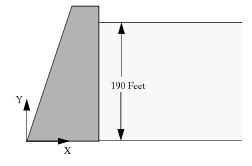XXXXXXXXXXXXXXXXXXXXXXXXXXXXXXXXXXXXXXXXXXXXXXXXXXXXXXXXXXXXXXXXXXXXXXXXXXXXXXXXXXXXXXXXXXXXXXXXXXXXXXXXXXXXXXXXXXXXXXXXXXXXXXXXXXXXXXXXXXXXXXXXXXXXXXXX''"> 1.4 Fields Example
Spatial PCL Function
An analyst is required to determine the stress on a dam near its capacity. The analyst decides to neglect all but the water pressure loads on the dam. As pressure is a function of depth, it is easily defined using a spatial field. Since the pressure distribution can be represented by a simple formula, the PCL Function method should be used. The configuration to be analyzed is shown below:
Due to certain modeling considerations, the analyst decides to put the origin of his model at the base of the dam. The analyst must now determine a formula which defines the pressure on the back of the dam in terms of his spatial coordinate system. Since

, it is clear that

.
As the density of water is 62.4 lb/ft3, and the maximum depth is 190 feet, the following PCL expression is entered in the “Scalar Function” databox:
(62.4 * 190) - (62.4 * ‘Y)
When selected as an edge load in the Loads/BCs create pressure form, this field will generate a pressure ranging from 0 psf at the surface to 11,856 psf at 190 feet. It is important to realize that this field is only meaningful for Y coordinates from 0 to 190. Care must be taken not to apply this field to entities greater in Y than 190 to prevent nonsensical negative pressures.

